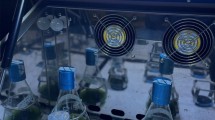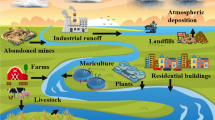Abstract
Marine sponges are sources of high-value bioactives. Engineering aspects of in vitro culture of sponges from cuttings (explants) are poorly understood. This work develops a diffusion-controlled growth model for sponge explants. The model assumes that the explant growth is controlled by diffusive transport of at least some nutrients from the surrounding medium into the explant that generally has a poorly developed aquiferous system for internal irrigation during early stages of growth. Growth is assumed to obey Monod-type kinetics. The model is shown to satisfactorily explain the measured growth behavior of the marine sponge Crambe crambe in two different growth media. In addition, the model is generally consistent with published data for growth of explants of the sponges Disidea avara and Hemimycale columella. The model predicted that nutrient concentration profiles for nutrients, such as dissolved oxygen within the explant, are consistent with data published by independent researchers. In view of the proposed model’s ability to explain available data for growth of several species of sponge explants, diffusive transport does play a controlling role in explant growth at least until a fully developed aquiferous system has become established. According to the model and experimental observations, the instantaneous growth rate depends on the size of the explant and all those factors that influence the diffusion of critical nutrients within the explant. Growth follows a hyperbolic profile that is consistent with the Monod kinetics.





Similar content being viewed by others
References
Barthel D (1989) Growth of the sponge Halichondria panicea in the North Sea habitat. In: Klekowski RZ, Styczynska-Jurewicz E, Falkowski L (eds) Proceedings of the 21st European Marine Biology Symposium, Gdansk, 14–19 September 1986 pp 23–30
Belarbi EH, Contreras Gómez A, Chisti Y, García Camacho F, Molina Grima E (2003a) Producing drugs from marine sponges. Biotechnol Adv 21:585–598
Belarbi EH, Ramírez Domínguez M, Cerón García M, Contreras Gómez F, García Camacho F, Molina Grima E (2003b) Cultivation of explants of the marine sponge Crambe crambe in closed systems. Biomol Eng 20:333–337
De Rosa S, De Caro S, Iodice C, Tommonaro G, Stefanov K, Popov S (2003) Development in primary cell culture of demosponges. J Biotechnol 100:119–125
Donia M, Hamman M (2003) Marine natural products and their potential applications as anti-infective agents. Lancet Infect Dis 3:338–348
Elvin DW (1976) Seasonal growth and reproduction of an intertidal sponge, Haliclona permollis (Bowerbank). Biol Bull 151:108–125
García Camacho F, Belarbi EH, Cerón García MC, Sánchez Mirón A, Chile T, Chisti Y, Molina Grima E (2005) Shear effects on suspended marine sponge cells. Biochem Eng J 26:115–121
García Camacho F, Chileh T, Cerón García MC, Sánchez Mirón A, Belarbi EH, Contreras Gómez A, Molina Grima E (2006) Sustained growth of explants from Mediterranean sponge Crambe crambe cultured in vitro with enriched RPMI 1640. Biotechnol Prog (in press). DOI 10.1021/bp050341m
Gatti S, Brey T, Müller WEG, Heilmayer O, Holst G (2002) Oxygen microoptodes: a new tool for oxygen measurements in aquatic animal ecology. Mar Biol 140:1075–1085
Hoffmann F, Larsen O, Rapp HT, Osinga R (2005) Oxygen dynamics in choanosomal sponge explants. Mar Biol Res 1:160–163
Jeshcke JM, Kopp M, Tollrian R (2004) Consumer-food systems: why type I functional responses are exclusive to filter feeders. Biol Rev 79:337–349
Jha RK, Zi-rong X (2004) Biochemical compounds from marine organisms. Mar Drugs 2:123–146
Kuhns WJ, Ho M, Burger MM, Smolowitz R (1997) Apoptosis and tissue regression in the marine sponge Microciona prolifera. Biol Bull 193:239–241
Martins AMP, Piciorenau C, Heijnen JJ, Van Loosdrecht MCM (2004) Three-dimensional dual-morphotype species modeling of activated sludge flocs. Environ Sci Technol 38:5632–5641
Mayer AM, Gustafson KR (2003) Marine pharmacology in 2000: antitumor and cytotoxic compounds. Int J Cancer 105:291–299
McMahon P (2000) System for the cell culture and cryopreservation of marine invertebrates. US Patent 6,054,317, 2000
Muldford AL, Villena AJ (2000) Cell cultures from crustaceans: shrimps, crabs and crayfish. In: Mothersill C, Austin B (eds) Aquatic invertebrate cell culture. Praxis Publishing, Chichester, pp 63–134
Müller WEG, Wiens M, Batel R, Steffen R, Borojevic R, Custodio MR (1999) Establishment of a primary cell culture from a sponge: primmorphs from Suberites domuncula. Mar Ecol Progr Ser 178:205–219
Nickel M, Brümmer F (2003) In vitro sponge fragment culture of Chondrosia reniformis (Nardo, 1847). J Biotechnol 100:147–159
Osinga R, Tramper J, Wijiffels RH (1999) Cultivation of marine sponges. Mar Biotechnol 1:509–532
Proksch P, Edrada RA, Ebel R (2002) Drugs from the seas—current status and microbiological implications. Appl Microbiol Biotechnol 59:125–134
Reiswig HM (1973) Population dynamics of three Jamaican demospongiae. Bull Mar Sci 23:191–226
Reiswig HM (1974) Water transport, respiration and energetics of three tropical marine sponges. J Exp Mar Biol Ecol 14:231–249
Rinehart KL, Jares-Erijman EA (1999) Antiviral and cytotoxic compounds from the sponge Crambe crambe. US Patent 5,952,332, 1999
Sipkema D (2004) Cultivation of marine sponges: from sea to cell. Ph.D. thesis, Wageningen University, Wageningen
Sipkema D, Osinga R, ScHihatton W, Mendola D, Tramper J, Wijffels RH (2005) Large-scale production of pharmaceuticals by marine sponges: sea, cell, or synthesis? Biotechnol Bioeng 90:201–222
Stewart PS (1998) A review of experimental measurements of effective diffusive permeabilities and effective diffusion coefficients in biofilm. Biotechnol Bieng 50(3):261–272
Stoodley P, de Beer D, Lewandowski Z (1994) Liquid flow in biofilm systems. Appl Environ Microbiol 60:2711–2716
Thakur NL, Müller WEG (2004) Biotechnological potential of marine sponges. Curr Sci 86:1506–1512
Turón X, Galera J, Uriz MJ (1997) Clearance rates and aquiferous systems in two sponges with contrasting life-history strategies. J Exp Zool 278:22–36
Turón X, Tarjuelo I, Uriz MJ (1998) Growth dynamics and mortality of the encrusting sponge Crambe crambe (Poecilosclerida) in contrasting habitats: correlation with population structure and investment in defence. Funct Ecol 12:631–639
Acknowledgements
Professor M. J. Uriz of the Centro de Estudios Avanzados de Blanes, Girona, Spain, is thanked for kindly arranging for the identification of the sponge. We are grateful to Consejería de Medio Ambiente de la Junta de Andalucía (Delegación Provincial de Almería) for permitting us to take samples of marine sponges in the Parque Natural de Cabo de Gata, Almería. This research was supported by the Ministerio de Ciencia y Tecnología (REN2001-2312-C03-03/MAR), Spain.
Author information
Authors and Affiliations
Corresponding author
Rights and permissions
About this article
Cite this article
Garcia Camacho, F., Chileh, T., Cerón García, M.C. et al. A bioreaction–diffusion model for growth of marine sponge explants in bioreactors. Appl Microbiol Biotechnol 73, 525–532 (2006). https://doi.org/10.1007/s00253-006-0495-2
Received:
Revised:
Accepted:
Published:
Issue Date:
DOI: https://doi.org/10.1007/s00253-006-0495-2




